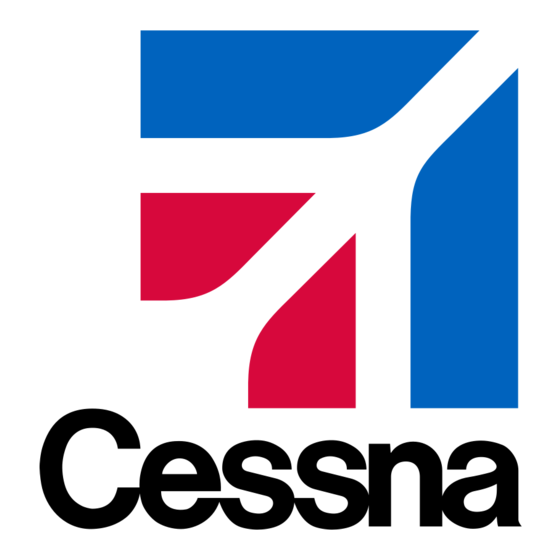
Table of Contents
Advertisement
Quick Links
Airspeeds
Vs0
41*- 40 degrees flaps
Vs1
55
Vx
80
Vy
90
Vfe
120
Va
118
Vno
146
Vne
182
Best Glide
80
*All speeds in Knots
Engine Specs
Continental IO520 D (Horizontally Opposed, 6 cylinder, Air Cooled)
300 HP @ 2850 RPM
Max RPM- 2850 RPM
Oil Type: Phillips X/C 20W50 or W100 Aeroshell
Max oil Capacity:
Normal Operations: 9-10 U.S. Quarts
Propeller Specs
Manufacturer: McCaulley
Prop Type: Constant Speed
Number Blades: 2
Prop Diameter: 86
Fuel
Capacity:
80 U.S. gallons – 40 each wing
Usable:
74 U.S. gallons
Fuel Burn:
16 Gallons Per Hour (average)
Fuel Type:
100/130 Aviation fuel or 100 LL
1976 Cessna A185F Seaplane N185AS
12 U.S. Quarts
Advertisement
Table of Contents

Summary of Contents for Cessna A185F 1976
- Page 1 1976 Cessna A185F Seaplane N185AS Airspeeds 41*- 40 degrees flaps Best Glide *All speeds in Knots Engine Specs Continental IO520 D (Horizontally Opposed, 6 cylinder, Air Cooled) 300 HP @ 2850 RPM Max RPM- 2850 RPM Oil Type: Phillips X/C 20W50 or W100 Aeroshell Max oil Capacity: 12 U.S.
- Page 2 Floats Manufacturer: Model: 582-3430 100% Bouyancy per Float: 3515 lbs. Float Airplane Bouyancy Max Floatation Weight 3430 C185 3515 lbs. 3905 lbs. 460 lbs.* <------------------------------- 21' --------------------------------> * without optional items...
- Page 3 Weight and Balance Gross Weight: 3525 lbs. Empty Weight: 2156 lbs. Useful Load: 1369 lbs. Float Storage Lockers: 100 lbs. maximum each side Sample Weight and Balance Weight Moment Empty Airplane 2156.15 40.40 87113.40 Front Seats 15500 Rear Seats Baggage Area 1 2000 Baggage area 2 3000...
- Page 6 EDO 3430 FAA Regulations Each float must have 4 compartments minimum Each float must support 90% of gross weight (both floats support 180%) Must be able to support the aircraft with two compartments flooded Note: The model number “3430” refers to the buoyancy of each float. Each Float will displace 3515 lbs of fresh water.
- Page 7 Preflight The preflight inspection of the airplane itself is accomplished same as the land-plane as described in the pilot’s operating handbook for that aircraft (usually involving a walk around inspection checking fuel, oil, lights, control operation, etc.) Carefully inspect the propeller for damage as water picked up under power is very harmful to an airplane prop (appearance is similar to gravel damage from a soft runway.) ...
- Page 8 Taxiing There are three ways to taxi a seaplane: Idle (displacement) Taxi Plow Taxi Step Taxi Idle Taxi In most cases idle taxi is the preferred taxi method. It generally allows the easiest maneuvering of the airplane in tight areas, around docks, boats, other seaplanes etc. For idle taxi: ...
- Page 9 Example of a plowing turn initiated by a slight turn off the wind in the opposite direction...
- Page 10 Step Taxi Step taxi is used under ideal wind conditions to cover long distances across the water. There is little or no spray problem when the floats are planning or “on the step,” and the attitude of the airplane provides adequate engine cooling and good visibility. When the airplane is on the step the elevator control is used to find the “sweet spot”...
- Page 11 Normal Takeoff and Climb DOORS AND WINDOWS CLOSED, SEATBELTS FASTENED Fuel……………………………………………….check Trim………………………………………………set Flaps……………………………………………..20 degrees Area………………………………………………clear Rudders…………………………………………up Stick………………………………………………full aft Throttle…………………………………………full open Stick………………………………………………adjust for sweet spot Airspeed………………………………………..accelerate to 70 after airborne Flaps………………………………………………retract to 10 degrees ...
- Page 12 Glassy Water Takeoff and Climb Glassy water makes it more difficult to unstuck the airplane from the water due to maximum friction between the floats and the water. Rolling the aircraft up onto one float can be an effective technique for getting airborne in this situation.
- Page 13 Downwind Throttle……………………20 Inches manifold pressure (18 inches mid-downwind) Abeam intended Touchdown Point Throttle……………………16 Inches manifold pressure Flaps………………………..10 degrees Airspeed…………………..90 Trim…………………………as required GUMPS check Base Leg Throttle……………………14 Inches manifold pressure Flaps…………………………20 degrees Airspeed………………….80 ...
- Page 14 The pilot should therefore select a long shoreline and land parallel to it using it as a height reference for the landing. In our Cessna 180 Seaplane, on final as the plane reaches the shoreline or object that the pilot has selected as a last visual reference, the airplane is pitched up to 65 miles per hour (approx.
- Page 15 Throttle…………………….As necessary to allow low approach 50 feet or less Airspeed……………………70 After Shoreline/Last Visual Reference Nose up…………………….65 mph Throttle…………………….2000 RPM After Touchdown Throttle…………………….close Stick………………………….slowly aft as seaplane falls off step The consequences of misjudging height above the water Confined Area Approach and Landing Downwind ...
- Page 16 Throttle…………………….As necessary Flaps…………………………30 degrees Airspeed……………………70 Forced Landing At first sign of aa engine failure attempt to troubleshoot the problem using the memory items from the emergency checklist (carb heat, fuel quantity, fuel selector, mixture, primer handle, mags, etc.) If a restart is unsuccessful, an emergency landing site must be selected.
- Page 18 Seaplane Parking There are several ways we can secure the airplane on the water: Docking Beaching Mooring/Anchoring Remember to remove seatbelts, headsets, and unlatch cabin doors before docking/beaching. It is up to you to catch the airplane! Docking When possible, the aircraft should always be docked into the wind.
- Page 19 1. What are the requirements for obtaining an Airplane Single Engine Sea (ASES) rating? 2. What must you do to keep your seaplane privileges current? 3. Name the three ways to taxi a seaplane. Which of these is the least favorable? Why? ...











Need help?
Do you have a question about the A185F 1976 and is the answer not in the manual?
Questions and answers